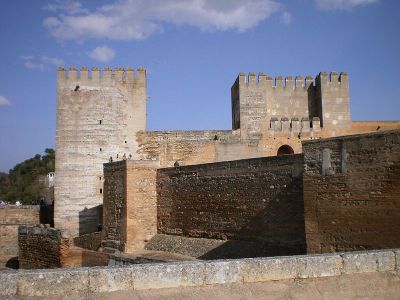Alcazaba Fortress, Granada
Muslims and mulwalladins (converts to Islam) never really got along well. Not even in the ninth century. Sawwar ben Hamdun found it necessary to build a fort. The current Alcazaba was built by Mohammed I. He threw up a rampart around Hamdun's works, improved defenses and erected three towers.
The towers were the Broken Tower (Torre Quebrada), the Keep (Torre del Homenaje), and the Watch Tower (Torre de la Vela). The Watch Tower is the favorite among visitors for its stunning views of the city and the surrounding mountains. Mohammed liked it because he could see his enemies when they were yet far away.
The Catholic Monarchs installed a huge bell in the Watch Tower called La Vela (the Sentinel). La Vela would always be rung on significant state occasions. It also rings to observe the Day of Conquest (Dia de la Toma), each January 2nd.
Below the tower flows the River Darro. The right bank is lined with ancient bridges, priories and palaces. In view are the Chancilleria, the Plaza Nueva, and the Paseo de los Tristes. There are four other towers: The Arms Tower (Torre de las Armas), the Justice Tower (Torre de la Justicia), and the two Vermillion Towers (Torres Bermejas).
The Mexican Poet, Francisco A. de Acaza, left these words on the wall in the garden of the Ramparts of Alcazaba: "...there is nothing in this life like the grief of being blind in Granada."
The towers were the Broken Tower (Torre Quebrada), the Keep (Torre del Homenaje), and the Watch Tower (Torre de la Vela). The Watch Tower is the favorite among visitors for its stunning views of the city and the surrounding mountains. Mohammed liked it because he could see his enemies when they were yet far away.
The Catholic Monarchs installed a huge bell in the Watch Tower called La Vela (the Sentinel). La Vela would always be rung on significant state occasions. It also rings to observe the Day of Conquest (Dia de la Toma), each January 2nd.
Below the tower flows the River Darro. The right bank is lined with ancient bridges, priories and palaces. In view are the Chancilleria, the Plaza Nueva, and the Paseo de los Tristes. There are four other towers: The Arms Tower (Torre de las Armas), the Justice Tower (Torre de la Justicia), and the two Vermillion Towers (Torres Bermejas).
The Mexican Poet, Francisco A. de Acaza, left these words on the wall in the garden of the Ramparts of Alcazaba: "...there is nothing in this life like the grief of being blind in Granada."
Want to visit this sight? Check out these Self-Guided Walking Tours in Granada. Alternatively, you can download the mobile app "GPSmyCity: Walks in 1K+ Cities" from Apple App Store or Google Play Store. The app turns your mobile device to a personal tour guide and it works offline, so no data plan is needed when traveling abroad.
Alcazaba Fortress on Map
Sight Name: Alcazaba Fortress
Sight Location: Granada, Spain (See walking tours in Granada)
Sight Type: Religious
Guide(s) Containing This Sight:
Sight Location: Granada, Spain (See walking tours in Granada)
Sight Type: Religious
Guide(s) Containing This Sight:
Walking Tours in Granada, Spain
Create Your Own Walk in Granada
Creating your own self-guided walk in Granada is easy and fun. Choose the city attractions that you want to see and a walk route map will be created just for you. You can even set your hotel as the start point of the walk.
Granada Introduction Walking Tour
The story of the city of Granada does not properly begin until the Umayyad conquest of 711 AD. The Iberian peninsula fell under Moorish rule that would last 700 years and the Jewish settlement of Garnata al-Jahud grew to become Granada of Al-Andalus.
The long Reconquest of Spain finally ended when the Emirate of Granada was ceded by Mohammad XII to the Catholic Monarchs, Ferdinand II of Aragon... view more
Tour Duration: 3 Hour(s)
Travel Distance: 3.5 Km or 2.2 Miles
The long Reconquest of Spain finally ended when the Emirate of Granada was ceded by Mohammad XII to the Catholic Monarchs, Ferdinand II of Aragon... view more
Tour Duration: 3 Hour(s)
Travel Distance: 3.5 Km or 2.2 Miles
Alhambra Walking Tour
One of the first places a tourist wants to visit in Granada is Alhambra, the region’s most iconic sight. By far not a typically Spanish attraction, this enormous fortress encompasses palaces, gardens, courtyards, and is the greatest surviving relic of Andalusia’s 800 years of Moorish rule. The sprawling complex sits forbiddingly atop the Darro valley, against a dramatic backdrop of the... view more
Tour Duration: 2 Hour(s)
Travel Distance: 2.0 Km or 1.2 Miles
Tour Duration: 2 Hour(s)
Travel Distance: 2.0 Km or 1.2 Miles
Albayzín Walking Tour
The Moorish quarter of Albaycín is a world of its own inside Granada. Mainly, this is due to a strong Islamic vibe still present in the area. The city's oldest district was established by Arabs in the 11th century and to date has retained much of its original charm, manifested in the neat maze of narrow Medieval lanes, shady, intimate courtyards and squares, plus a multitude of well-kept,... view more
Tour Duration: 2 Hour(s)
Travel Distance: 2.3 Km or 1.4 Miles
Tour Duration: 2 Hour(s)
Travel Distance: 2.3 Km or 1.4 Miles
Granada's Architectural Jewels
Over the course of centuries, Granada's architecture has been influenced by four major styles – Moorish, Renaissance, Gothic and Baroque. The city’s most impressive buildings date from the period of Arabic rule and the subsequent Catholic epoch which started after the Moors were displaced in 1492.
From the dazzling majesty of the Alhambra to the awe-inspiring churches and the subtly... view more
Tour Duration: 2 Hour(s)
Travel Distance: 3.5 Km or 2.2 Miles
From the dazzling majesty of the Alhambra to the awe-inspiring churches and the subtly... view more
Tour Duration: 2 Hour(s)
Travel Distance: 3.5 Km or 2.2 Miles







